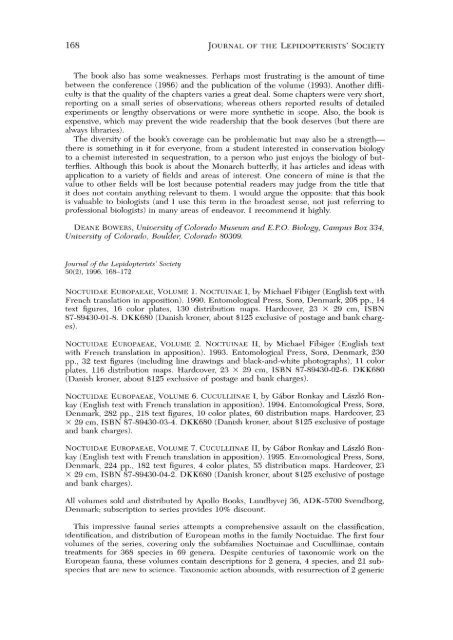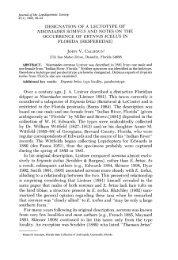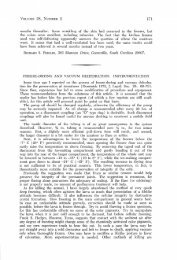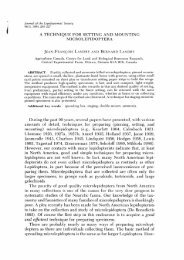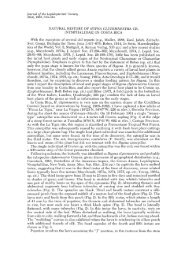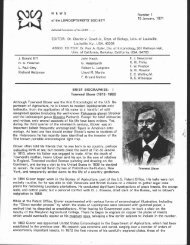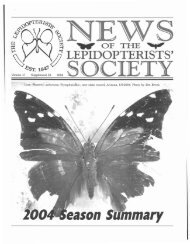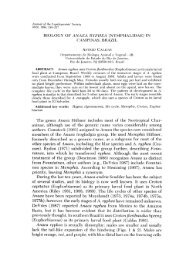Noctuidae Europaeae, Volumes 1, 2, 6, 7 - Yale University
Noctuidae Europaeae, Volumes 1, 2, 6, 7 - Yale University
Noctuidae Europaeae, Volumes 1, 2, 6, 7 - Yale University
Create successful ePaper yourself
Turn your PDF publications into a flip-book with our unique Google optimized e-Paper software.
168 JOURNAL OF THE LEPIDOPTERISTS' SOCIETY<br />
The book also has some weaknesses. Perhaps most frustrating is the amount of time<br />
between the conference (1986) and the publication of the volume (1993). Another difficulty<br />
is that the quality of the chapters varies a great deal. Some chapters were very short,<br />
reporting on a small series of observations; whereas others reported results of detailed<br />
experiments or lengthy observations or were more synthetic in :;cope. Also, the book is<br />
expensive, which may prevent the wide readership that the book deserves (but there are<br />
alwavs libraries).<br />
The diversity of the book's coverage can be problematic but may also be a strengththere<br />
is something in it for everyone, from a student interested in conservation biology<br />
to a chemist interested in sequestration, to a person who just enjoys the biology of butterflies.<br />
Although this book is about the Monarch butterfly, it ha; articles and ideas with<br />
application to a variety of fields and areas of interest. One concern of mine is that the<br />
value to other fields will be lost because potential readers may judge from the title that<br />
it does not contain anything relevant to them. I would argue the opposite: that this book<br />
is valuable to biologists (and I use this term in the broadest sense, not just referring to<br />
professional biologists) in many areas of endeavor. I recommend it highly.<br />
DEANE BOWERS, <strong>University</strong> of Colorado Museum and E.PO. Biology, Campus Box 334,<br />
<strong>University</strong> of Colorado, Boulder; Colorado 80309.<br />
Journal of the Lepidopterists' Society<br />
50(2), 1996. 168-172<br />
NOCTUIDAE EUROPAEAE, VOLUME L NOCTUINAE 1, by Michael Fibiger (English text with<br />
French translation in apposition). 1990. EntomolOgical Press, Som, Denmark, 208 pp., 14<br />
text figures, 16 color plates, 130 distribution maps. Hardcover, 23 X 29 cm, ISBN<br />
87-89430-01-8. DKK680 (Danish kroner, about $125 exclusive of postage and bank charges).<br />
NOCTUIDAE EUROPAEAE, VOLUME 2. NOCTlJTNAE II, by Michael Fibiger (English text<br />
with French translation in apposition). 1993. Entomological Pre:;s, Sor~, Denmark, 230<br />
pp., 32 text figures (including line drawings and black-and-white photographs), 11 color<br />
plates, 116 distribution maps. Hardcover, 23 X 29 cm, ISBN 87-89430-02-6. DKK680<br />
(Danish kroner, about $125 exclusive of postage and bank charges).<br />
NOCTUIDAE EUROPAEAE, VOLUME 6. CUCULLIINAE 1, by Gabor Honkay and Laszl6 Ronkay<br />
(English text with French translation in apposition). 1994. EntomolOgical Press, Sor~,<br />
Denmark, 282 pp., 218 text figures, 10 color plates, 60 distribution maps. Hardcover, 23<br />
X 29 cm, ISBN 87-89430-03-4. DKK680 (Danish kroner, about $12.5 exclusive of postage<br />
and bank charges).<br />
NOCTUIDAE EUROPAEAE, VOLUME 7. CUCULLIINAE II, by Gabor Honkay and Laszl6 Ronkay<br />
(English text with French translation in apposition). 1995. Emomological Press, Sor~,<br />
Denmark, 224 pp., 182 text figures, 4 color plates, 55 distribution maps. Hardcover, 23<br />
X 29 em, ISBN 87-89430-04-2. DKK680 (Danish kroner, about $125 exclusive of postage<br />
and bank charges).<br />
All volumes sold and disttibuted by Apollo Books, Lundbyvej 36, ADK-5700 Svendborg,<br />
Denmark: subSCription to series provides 10% discount.<br />
This impressive faunal series attempts a comprehensive assault on the classification,<br />
identification, and distribution of European moths in the family <strong>Noctuidae</strong>. The first four<br />
volumes of the series, covering only the subfamilies Noctuinae alld Cuculliinae, contain<br />
treatments for .368 species in 69 genera. Despite centuries of taxonomic work on the<br />
European fauna, these volumes contain descriptions for 2 genera. 4 species, and 21 subspecies<br />
that are new to science. Taxonomic action abounds, with resurrection of 2 genetic
VOLUME 50, NUMBER 2 169<br />
names, changes in status for 51 species-group names, and new synonymies for 104 speciesgroup<br />
names and 3 genera!<br />
All volumes are attractively and securely bound with pale gray covers, the spine lettering<br />
giving se ries and volume titles in bold black. Layout of the text throughout is in two<br />
parallel columns, the left in English and the right in French. Format, choice and variation<br />
of fonts, and integration of text with range maps is attractive and convenient. Volume 1<br />
has a small number of incorrect spellings in the text, including at one point the author's<br />
own name, with occasional confusion between 'synonomy' and synonymy. The other volumes<br />
appear quite free of errors.<br />
The presswork is exceptional, the text on glossy white paper of neutral pH, and the<br />
color plates on matte paper with high resolution and excellent rendition, much better<br />
than plates in earlier fascicles of the Moths of America North oj Mexico series well known<br />
to American readers, and competitive with plates in more recent fascicles in that series.<br />
With few exceptions the specimens illustrated are in excellent condition, well prepared,<br />
and photographed en m
170 JOURNAL OF THE LEPIDOPTERISTS' SOCIETY<br />
genitalia" are referred to, but the actual structures are not, leaving readers to unravel<br />
those features for themselves.<br />
The Bionomics sections are informative, elaborating on habitats, dominant vegetation,<br />
phenology, daily adult activity cycles, and, in some cases, resting postures and feeding<br />
habits of both adults and larvae. Foodplants are identified with scientific names whenever<br />
pOSSible.<br />
The geographic area of coverage extends from Iceland and the Azores to the Ural<br />
Mountains, but does not include Turkey, Cyprus, the Middle East or Northern Africa. A<br />
Single standard base map depicting political boundaries for the entirety of Europe is used<br />
in all volumes to illustrate ranges for each species. The maps are not numbered, labelled<br />
only with a binomen, and are not cited in the text. Subspecies are not mapped separately<br />
and maps for species do not distinguish the presumably allopatric or parapatric distribution<br />
of subspecies. Distributions are presented as areas bounded by a thick line and shaded<br />
with broad stripes through which political boundaries within the range remain clearly<br />
visible. Ranges are stated to be schematic representations of more preCise maps produced<br />
by a project entitled "Faunistica Lepidopteron.lm Europaeon.tm." In fact, the shaded areas<br />
are quite gencralized, leaving the reader with a feeling of unce rtainty as to how literally<br />
one might interpret occurrence based solely on them.<br />
The References section at the end of each volume is very complete and inclusive, but<br />
regrettably all periodical titles are abbreviated, making obscUJ'e references difficult to<br />
locate for readers without bibliographic experience or a friendly librarian. Indices wisely<br />
include names of the genus group as well as those of the species group, but in <strong>Volumes</strong><br />
1 and 2 no explanation is offered for the use of semibold page numbers to locate principal<br />
treatments. Indices for <strong>Volumes</strong> 6 and 7 correct this problem and add figure numbers for<br />
genitalia. Plate numbers are not included in the indices, and readers are forced to look<br />
up the species account in order to obtain plate citations. Unfortunately no index to foodplants<br />
is prOVided, and common names are not mentioned. Both features would have<br />
broadened the appeal of the series, and more importantly, increased its utility as a reference<br />
work for use by non-speCialists.<br />
Genitalia are illustrated for only a few species in <strong>Volumes</strong> 1 .md 2. Although citations<br />
for genitalia illustrations in other publications are given for many species, and a comprehensive<br />
set of illustrations is promised in a still unpublished volume 3, the situation is<br />
frustrating for users who desire genitalic confirmation and haVE no access to other literature.<br />
<strong>Volumes</strong> 6 and 7 correct this problem with complete illustration of the genitalia<br />
for both sexes. These are accurate tracings of actual preparations reproduced at large size,<br />
only one or two per page, but in detail and presentation are not up to the illustration<br />
standards of other faunistic works.<br />
VOLUME 1 primarily covers the Agrotini of Lafontaine (198/'), and treats 137 species<br />
in 16 genera including prodigious assemblages in Euxoa and A'!,rotis. Systematically difficult<br />
taxa in Dichagyris and Yigoga (= Ogygia of Hubner) are treated in detail, complicated<br />
by the faunistic nature of the series which prevents thorough treatment of extralimital<br />
taxa for these Pale arctic lineages.<br />
Discussion of the Hypericum-feeding genus Actinotia in Volume 1 is informative, but<br />
the evidence presented makes its retention in Volume 1 enigmatic. American readers will<br />
wonder why the closely related New World genus Nedra is not mentioned, as the two<br />
genera are classic examples of how excessive adherence to Single Hampsonian features<br />
(in this case tibial spinulation) can result in preposterous sub familial placement of closely<br />
related lineages. Equally confUSing, but less resolved, is the inclusion of the single European<br />
species of Arylia.<br />
New World readers will recognize the distinctive Bame-shouldered dart (Ochropleura<br />
plecta) in the plates. The genus Ochropleura is considered to be a basal lineage of Noctuini<br />
by Lafontaine (1987). Its generic limits are very hroadly construed in Volume 1,<br />
although paraphyly of that grouping is acknowledged.<br />
Two new species and nine subspecies are described in the main text of Volume 1, with<br />
authorship diversely credited to Fibiger, Moberg and F'ibiger, OJ' Fibiger and Moberg. All<br />
possible combinatOlials in nomenclature are nearly attained in the Appendix, where an<br />
extralimital species, Euxoa mobergi Fibiger, is described!
VOLUME 50, NUMBER 2 171<br />
VOLUME 2 treats 116 species in 27 genera, primarily those placed in Noctuini of Lafontaine<br />
(1987), but including Peridroma, a genus Lafontaine considered to be a basal<br />
lineage of Agrotini. Fibiger proposes one new genus, Divaena, ancl two other genera are<br />
resurrected from synonymy. Fifty-one species-group names are pronounced as new synonyms,<br />
and 14 undergo revisions in status. Six new subspecies are described. Volume 2,<br />
in contrast to Volume 1, benefits greatly from Fibiger's active communication with other<br />
specialists, especially with the world doyen of noctuine systematists. J, D. Lafontaine, who<br />
provides critical information on delimitation of many genera, including Epipsilia, Rhyacia,<br />
Cyrehia, Protolampra, Eugraphe, and Coenophila, as well as advice on relationships of<br />
Peridroma and the classification of the Xestia complex. American I-eaders will appreciate<br />
illustration of two showy species recently introduced into North Arr,erica, Noctua pmnuba<br />
and N. comes, and will notice that North American Xestia (Megaserna) adela Franclemont<br />
is considered a subspecies of X. c-nigrum (Linnaeus), with X. dolosa Franclemont treated<br />
as a distinct species.<br />
The genus Mesogona is admittedly misplaced in Volume 2, but retained because it was<br />
included in the plates prior to recognition of its relationship to Enargia, Cosmia, Ipimorpha,<br />
and other genera histOrically placed in a polyphyletic Amphipyrinae or more recently<br />
in Ipimorphinae by European workers. A corrigenda in Volume 2 provides input from<br />
various active European specialists on errors of omission and commission in Volume 1.<br />
Unlike <strong>Volumes</strong> 1 and 2 by Fibiger, <strong>Volumes</strong> 6 and 7 by Ronhy and Ronkay attempt<br />
to provide phylogenetic clarification for the lineage under discussio;), the Cuculliinae. This<br />
subfamily is considered by them to contain five tribes of uncertain relationship, including<br />
Cuculliini (Cucullia and kin), Oncocnemidini, Psaphidini, Feraliini, and Episemini. Their<br />
phylogenetic conclusions are similar to those of R. W, Poole (199.5, Nnctuoidea. <strong>Noctuidae</strong><br />
(Part). Cucullinae, Stiriinae, Psaphidinae (Part), Moths of America North of Mexico, Fascicle<br />
26.1, The Wedge Entomological Foundation, Washington, D.C.) for the Nearctic<br />
fauna, although Poole treats the lineages as subfamilies (Cucullimae, Oncocnemidinae,<br />
and Psaphidinae with Feraliini as one of six Nearctic tribes). Nomenclature enthusiasts<br />
will enjoy figuring out senior authorship for the flurry of family-group names being proposed,<br />
but phylogeneticists may conclude little with confidence a~; extensive comparative<br />
analyses have not yet been made, especially for pupal and larval structures that might<br />
c1ari£}- parallel trends observed in adults features, especially genitalia. Both works will<br />
introduce Don-specialists to new subfamily classifications for trifine noctuids that contrast<br />
sharply with the traditional system in use for nearly a century based on Hampson's classic<br />
Catalogue of the Lepidoptera Phalaenae in the British Museum (1903-1913), Even novices<br />
will note the disappearance of Lithophane, Eupsilia, Xylena, and related genera of pinion<br />
and sallow moths from the "new" Cuculliinae, leaving only Cucullia and close kin, with<br />
the predominantly eremic oncocnemidines as a likely sister group. Relationship of the<br />
weaker-tongued sallow moths such as species of Feralia, Brachionycha, Asteroscopus, and<br />
Lampmsticta are much less convincing, but together they may constitute a lineage including<br />
Nearctic Psaphida.<br />
VOLUME 6 begins with a comprehenSive and fully revised checklist of the tribe Cuculliini<br />
for the Palearctic Region. Species accounts are provided for the entirety of the European<br />
fauna consisting of 60 species in just three genera, Cucullia (sensu stricto), its<br />
segregate Shargacucullia, and the monotypic Calocucullia. The former two genera are<br />
each divided into several species groups. Poole (199.5) agrees that Shargacucullia may be<br />
monophyletiC, but aptly questions the wisdom of separating it from Cucullia (s.s,) as<br />
together they comprise the long accepted and undoubtedly monophyletiC genus Cucttllia<br />
(sensu lato). SpeCies accounts in Volume 6 are detailed and the diagnoses extensive, giving<br />
an impression of thoroughness, precision, and much thought by the authors. One new<br />
species and one new subspecies are proposed in Volume 6; 11 species-group names are<br />
given revised status, and six names are newly treated as synonyms.<br />
VOLUME 7 contains treatments for 23 genera and .5.5 species, covering European relatives<br />
of cuculliine taxa placed by Poole (199.5) in the Oncocnemidinae. One new genus<br />
and five new subspecies are proposed; three generic names and four speCies-group names<br />
are newly synonymized, and an additional 16 names undergo changes in status, As in<br />
Volume 6, species treatments in Volume 7 are quite thorough, with detailed discussion
172 JOUHNAL OF THE LEFlDOPTEHISTS' SOCIETY<br />
and illustration of the genitalia of both sexes. The Bionomics sections are full of de tail,<br />
including larval foodplants and comments on activity periods during the night reflecting<br />
tbe autbors' substantial field experience.<br />
The lineages covered in Volume 7 have their greatest diversity in tbe New World, and<br />
clear understanding of relationships must await revision of the extensive Nearctic fauna<br />
as well as resolution of enigmatic taxa from the southern neotropics. Calophasia lunula,<br />
a recent introduction to North America feeding on both alien and native species of Linaria,<br />
is stated to be hoI arctic without clarification of its history in the Nearctic.<br />
Volume 7 does have some confusing problems in organization, such as Plate 4 and its<br />
caption on page 144 appearing before the conclusion of the caption for Plate :3 on page<br />
14.5. or the 76 pages of plates and figures (pp. 136-211) separating the main text from its<br />
I ast four pages.<br />
Funding permitting. additional volumes of Nnctl1iriae Europlleae will soon appear. If<br />
these continue to improve in response to modern analyses of phylogeny while maintaining<br />
the current high quality of the published volumes, the series will become the most impressive<br />
regional fauna in existence for any family of moths. Encyclopedic coverage of the<br />
regional fauna, combine d with superb color illustrations of adults and a comprehensive<br />
concatenation of literature and personal communications from world speCialists, have already<br />
made this selies a truly magistral contlibution Oil the <strong>Noctuidae</strong> of Europe.<br />
JOH N E. RAWLINS. Carnegie Museum of Natural History, 4400 Forbes Avenue, Pittsburgh,<br />
Pennsylvania 1 S213-4080.<br />
j uurnal of thr: Lr'Pir/lrpterists' SOciety<br />
.50(2 ), 1890. l72<br />
CORRECTION TO VOLUME SO<br />
In the article by George Austin, "H esperiidae of central Rondonia<br />
Brazil: thrce new species of Narcosius" which appeared in 50(1):54- 60,<br />
the adults on page 56 are numbered incorrectly. The caption should<br />
read: "FIGS. 1-4. 1. Narcosius steinhauseri, holotype male. 2. Narcosius<br />
odysseus, holotype male. 3. Narcosius pseudomura, holotype male. 4.<br />
Narcosius mum, male (BRAZIL: Rondonia; 62 km S Ariquemes, linea<br />
C-20, 7 km E 13-6,5, Fazenda Rancho Grande). On all figures, venter<br />
on left:, dorsum on right." Similarly, on page 55, "(Figs. 3, 8)" should<br />
appear under Narcosius pseudomura; on page 57, under Diagnosis and<br />
DisclJssion, Narcosius mura should be noted as illustrated in "(Fig. 4);"<br />
and on page 57, "(Figs. 2, 6)" should appear under Narcosius odysseus.<br />
Date of Issue (Vol. .50, No.2): .5 July 199G


